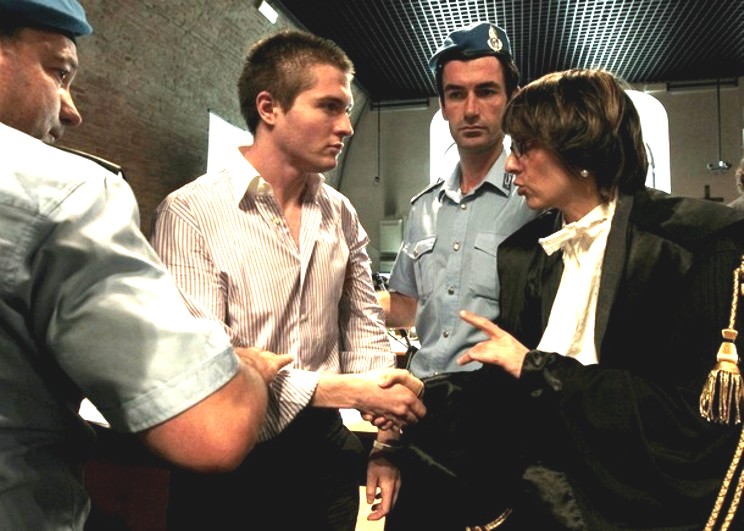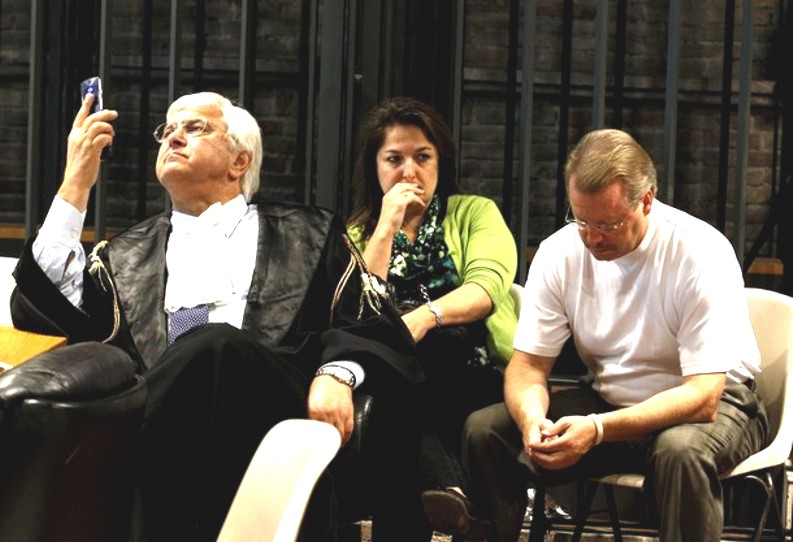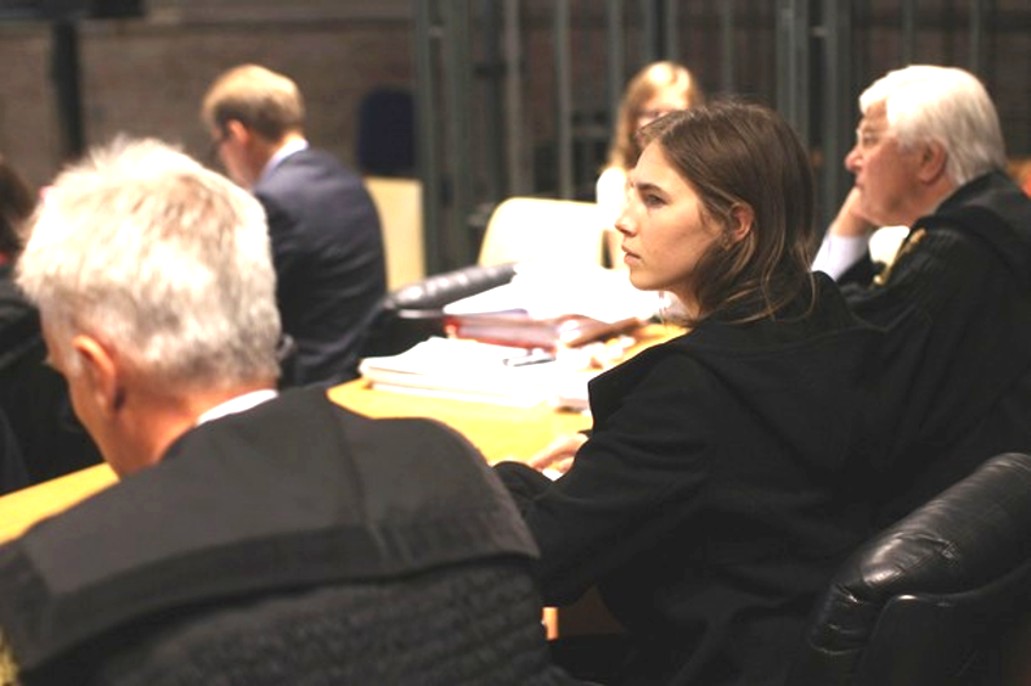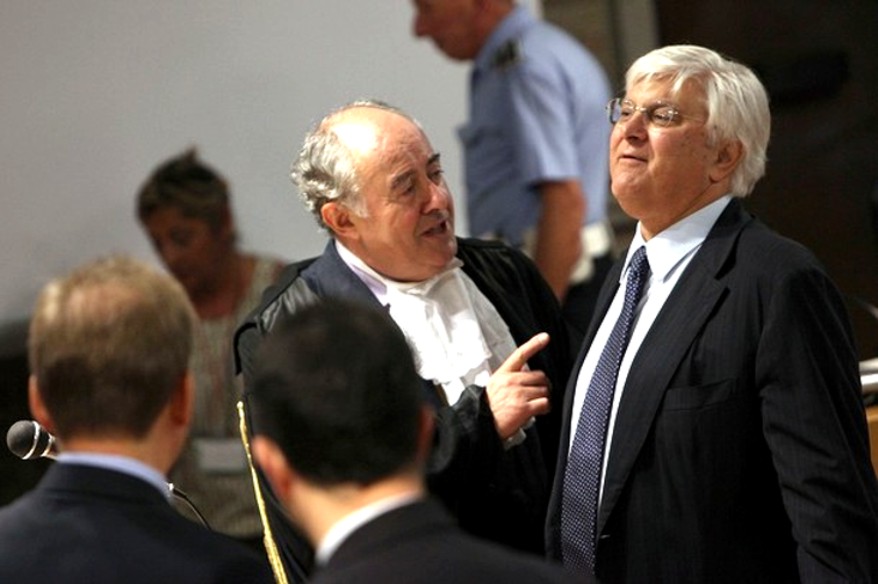I am C/P this article in full as this link seems to disappear only to re-appear
http://womanonawire.blogspot.com/2011/09/unarresting-arrested-famed-fbi-profiler.html
This article was originally supposed to be published for Il Messaggero. It was given to me as an assignment, after the editor and legal expert of the newspaper saw the Maxim interview with famed FBI profiler, John Douglas, in the January 2011 issue.
When the article was turned in, albeit shortened, my editor told me – “this article is too dangerous to print in Italy”.
So, for your reading pleasure, the article too dangerous for Italy.
There are two kinds of hunters: the hunter that waits and the hunter that tracks. The difference of two is the complexity of their hunting techniques though both aim for the same thing; bagging the prey.
Hunters who wait prefer to lure their prey into range. This is usually the preferred method of serial killers. They watch, and wait for the chance to pounce. Hunters who track their prey, involves a more detailed approach; knowing the specific differences, patterns and behaviors of the hunted, and calculate their next moves. John Douglas is of the latter. However, he pursues a different kind of animal: serial killers. He is the investigator and legendary criminal profiler known as “The Mind Hunter”.
When Douglas joined the FBI at 25 years old, no agents were interviewing captured killers. He began his study in prisons, speaking with hundreds of criminals to understand who they were, and what motivates them to kill. “They want to talk. Many are proud of what they accomplished. In my interviews, I try to make them feel comfortable, and speak with them in what they desire most; as a fan”. And they talked, one by one – from Ed Gein, (whose real life-adventures were fictionalized in Psycho and The Silence of the Lambs), Charles Manson, Ted Bundy, Son of Sam, to Jeffrey Dahmer, among other nefarious, infamous criminals that have roamed the earth.
Manson is a great example of Douglas’s approach. “I’m 6’2”, Manson is 5’4”, Douglas says. “I knew he’d want to dominate the room. He stood on a chair during the entire interview. It seemed to make him comfortable, so I let him. All I wanted was information, that’s my goal”.
Pioneering modern criminal profiling 25 years ago in the FBI, Douglas helped create the Behavioral Science Unit (BSU). “My first office was in Detroit. Back then, we had about 800 homicides a year. It may be a terrible place to live, but for a young agent, it was a great place to learn”. Criminal Profiling has been an accepted method in American murder investigations since the late 70’s.
The job took its toll in 1985, when he nearly died. He came down with viral encephalitis; his body temperature reached 107 degrees, his pulsed raced to over 220 and had uncontrollable seizures. The tombstone was already etched with his name and the grave site chosen. It was years of physical rehabilitation. But Douglas was back on the job 5 months later to nab The Green River killer and countless mass murderers before retiring in 1995.
“It’s tough. You’re alone, with this extraordinary pressure, especially the in-between. Here I am trying to work a case, which in of itself takes a toll; looking at what the murderer did, horrifying things, forcing myself to enter their twisted, sick minds, then add in the factor that you are not always welcome by local law enforcement, even hated at times – even with my background. It gets to you, it really does”.
Bestselling author of over a dozen novels, books and manuals, he was the inspiration for Jack Crawford’s character in “The Silence of the Lambs” and probably ever other fictional detective/investigator that a screenwriter used to sculpt their characters.
In addition, Charlize Theron’s company optioned Douglas’s biography, “Mindhunter” for HBO.
Since retiring as head investigator for the National Center for the Analysis of Violent Crime at the FBI, Douglas now travels the world hired by international and domestic law enforcement and defense teams who request his help in investigations.
Criminal Behavioral Profiling has also proved to be a useful tool in exonerating the wrongly accused or convicted, of which Douglas also dedicates his time.
Probably the most well-known of these was the JonBenét Ramsey case. The case is notable for both its longevity and the media interest it generated. The media and local law enforcement agencies considered the girl's parents and brother to be suspects. Douglas was the first to publicly proclaim their innocence, long before DNA legally exonerated them. He was vilified not only in the press, but by his colleagues as well.
Douglas has worked on over 5,000 cases, hired by domestic and international defense teams and law enforcement. Of those 5,000 cases, he’s never been proved wrong. “I think that’s probably the biggest pressure, is the possibility of being wrong and why I got sick”, Douglas tells me.
In the January issue of Maxim, Douglas said he was convinced that Amanda Knox and Raffaele Sollecito are innocent. In February, I conducted this interview with Douglas. This is it in its entirety.
KE: How do you analyze and create a profile in a case?
JD: Criminal investigative analysis or what you call “criminal profiling” is the overall process whereby crimes are reviewed in their totality. It involves the process of criminal investigative analysis both by behavior and investigative perspective. We interpret the behavior before, during and after the crime. From that, we develop strategies and profile the unknown subject, or UNSUB. Then we assess the suspects, the UNSUB, and provide interrogation techniques.
One must be able to identify with both the victim and the suspect, in order to answer the investigative of formula of: why + how = who.
JD: The criminal profiling process alone does not convict anyone. The foundation of any case is a properly conducted, thorough and well planned investigation. If the investigation is not good, the results will be tainted. Garbage in…garbage out!
KE: What did you know about the case beforehand, and what interested you?
JD: I really didn’t know much about the case. Just what I read in passing – perhaps it’s just as well. It had extraordinary media attention, and it was controversial. There seemed to be strong arguments on both sides. The public seemed convinced of either their innocence or their guilt. This always interests me.
KE: Did you speak with the Knox family?
JD: No. I’ve never met them. The case was brought to me by a former FBI agent who strongly believed they (Amanda Knox and Raffaele Sollecito) were innocent.
KE: Why did you decide to take this case, in particular?
JD: I thought I could come up with an analysis. I was interested to find the truth, and not be swayed by either side. In fact, whenever someone brings me a case, I tell them that my answer may not support their theories – you may not like what I have to say. I act like the lone ranger; I give my opinion without caring about the politics. I don’t care how it really works out; in my mind, I am working for the victim. Part of my downfall, the viral encephalitis, was due, in part, because people do not always necessarily like me or my findings.
KE: Did you feel you had all the information necessary or at your disposal to make your conclusion?
JD: I won't do an analysis unless I am provided with all the information necessary. In this case, I had everything I needed. In fact, more than I've had in other cases. Fortunately, I also had the crime scene evidence collection tapes to view. Often in America, we only have photos (of a crime scene) and you can't clearly understand what is happening. There was more than enough to assess.
KE: What was your conclusion of the behavioral profiles you conducted?
JD: From the profiles created, none of the behavioral or forensic evidence leads to Amanda and Raffaele. There's no history or experience related to violence or mental illness in their backgrounds. None of the behavioral or forensic evidence leads to Amanda and Raffaele. This is not a case of serial killers, cold blooded murderers. They used marijuana, but that’s not some hard core drug that will change a normal personality. Nothing exists in the background of the kids. They should’ve walked out of there.
KE: What behavioral evidence should there have been?
JD: Well, fleeing for one, which only Guede did. They would’ve been nervous, probably drinking heavily, become rigid in their personalities, behaviors along that line – certainly not buying underwear and kissing. The fact that they were kissing - people looked at this as a sign of guilt, if anything; I look at it as a sign of innocence. These two individuals – Amanda and Raffaele, for them to commit this horrific crime and leave the crime scene that way – it was a massacre – and then hours later, be back at the crime scene, just doesn’t fit. These are two young people who cannot fathom what has taken place. (It was so surreal) they thought they were going to stroll in and out of there and justice would prevail. But, it didn’t happen that way. Justice did not prevail.
KE: Do you believe more than one person could've killed Meredith?
JD: Based on my experience, the crime scene does not indicate the presence of three individuals in the room where Meredith was murdered. What was done to the victim, the way in which the crime occurred, was not the result of three people. This can be concluded without a DNA test.
KE: And third suspect, Rudy Guede?
JD: Behavior reflects personality. And that behavior fits only Rudy Guede. Guede has the history; he was an experienced criminal, he had the motive (are you listening, Mr. Pisa?*) and all evidence points to him. It was brutal, bloody homicide, and it’s a reflection of his personality. And that behavior was exhibited at the crime scene. That’s his “canvas”; the result is his “artwork” of the subject (victim).
You should be able to find other “canvases” of his like that – not necessarily homicide, but you should find a violent past in this person’s background. I know that he committed some robberies, but I’ll bet money there are more cases that he may have been involved with which remain unsolved. I don’t know, maybe before he came to Perugia – whatever he may have been escaping previously.
KE: What was the motive?
JD: The primary motive was burglary. But we have an opportunistic offender here. And that opportunity was presented when Meredith came home, and she became the victim of the opportunity.
KE: There are many who’ve said covering Meredith’s body with a duvet proves that the murderer was female.
JD: That’s absurd. There are different reasons why someone will cover a body. There's a certain sense of wanting to undo the crime. Guede didn’t leave after the crime, but he doesn’t want to look at her. It’s not that he didn’t feel good about what he has done; I can see that because of the way he killed her and sexually assaulted her. He’s a sadistic individual with a violent past. He put the blanket over her because he was wandering around the apartment and didn’t want to see her.
Sadly, this was a very pedestrian murder. And that’s not to diminish this beautiful woman’s life, Meredith. It’s not that complicated, crimes are not so complicated.
After a week, I would’ve said, “Are you kidding me? You mean you haven’t arrested the guy?”
KE: In your professional opinion, what went wrong?
JD: Let me first say, for the police in Perugia, they may only have the opportunity to see a case like this in a career. Unfortunately here, we see homicides like this all the time.
The first investigators didn’t know what they were handling. The collections and preservation of evidence was done incorrectly and led to contamination. Luckily we have the video; not only photos. You can see all the mistakes that were done. If I was brought in on this investigation, I would have told them they were on the wrong track.
KE: The media have been very interested and involved in this case from the beginning: do you think their role helped or damaged the investigator’s job and the judge’s assessments?
JD: It absolutely damaged both. The media can shape people's opinion. A single photograph seen out of context, can affect us. The investigators can also be responsible for leaking information to manipulate the media and thus, public opinion.
KE: Do you believe the investigators made mistakes that subsequently diverted the course of the investigation?
JD: Well, that’s the entire story, isn’t it? First, there were too many people in those rooms. They should have removed Amanda, Raffaele and anyone who was not part of the investigation team, and roped it off.
From the video taken from the crime scene, there were numerous mistakes. The investigators can be seen passing evidence, dropping it on the ground, using the same tweezers, not changing gloves, no protective caps to cover hair. Any insider can recognize these errors. What the investigators have done may seem right on the "outside", they had their protective clothing, boots, but cross- contamination of the evidence was more than evident.
KE: What is cross-contamination, exactly?
JD: It means simply that evidence from anyone, anyone who came and went in those rooms have the potential to leave their DNA, prints, etc. and run the risk of being transferred microscopically.
KE: Allegedly, DNA of Sollecito’s was said to have been found on Meredith's bra clasp. DNA of Amanda Knox’s is said to be on the murder weapon; on the knife’s handle and Meredith’s on the blade.
JD: It’s not the murder weapon. As far as I’m concerned, it hasn’t been found; probably never will. It doesn’t fit with the imprint made on the bed sheet, or the wounds found on Meredith. The evidence collection video from December
18th shows a knife, randomly chosen, from Sollecito’s apartment and transported to the lab.
The video taken on November 2nd shows the bra clasp, very clearly on the floor of the crime scene. On December 18th, after returning to the scene more than 16 times, the video shows the bra clasp, still there. It had already been kicked and shuffled around on the floor for six weeks! Secondly, the amount of DNA, supposedly, that was Sollecito’s, is highly suspect.
Moreover, if that’s all the evidence you’ve got, two tiny pieces of DNA, of the plethora that should have been there... well, it’s simply ludicrous.
KE: Are these errors by the investigators more common in Italy than in other parts of the world?
JD: Are all the investigators in Italy incompetent? Are they badly trained? Absolutely Not! The training is probably good, very good. But in any profession people get careless, they can get lazy. But this does not mean that the system does not work. Look at the West Memphis Three case. Just because there was incompetency there, does not mean all the investigators in Tennessee are incompetent.
KE: You understand that the Italian officials might see your conclusions on this case as an external interference.
JD: No one in Italy, America or elsewhere in the world, likes anyone looking over their shoulders. But I think if an investigation has been carried out accurately, without errors, you should not fear the analysis of other professionals.
KE: What about Amanda’s confessions during the interrogations?
JD: To be interrogated from 10 pm until 6 am in the morning? These are not sophisticated young people – it would not take a dozen interrogators to break them. I know the tricks, I know what they do in there; I’ve done it. No one could hold up. I couldn’t hold up - especially over 5 days.
KE: Amanda, while under interrogation accused another man, Patrick Lumumba. Why would she have done that?
JD: The police knew they had negroid hairs at the crime scene. Amanda exchanged texts the night before with Patrick Lumumba, who's of African descent, like Guede (Note: Lumumba owned the bar where Amanda worked as a waitress. He told her she wasn't needed for work that night). Because the DNA evidence had not come back yet, they jumped to the conclusion the hairs belonged to Lumumba. They interrogated her accordingly. The tactics used was to have Amanda say what the police wanted. You get people to confess under this psychological torture.
KE: Do you think the prosecution acted based on prejudices towards Amanda and Raffaele?
JD: I don’t think prejudice is exactly correct. The prosecution had a theory from the beginning and continued with it – despite the facts. They discounted evidence that didn’t support their theory. Their theory was a threesome murder and let this theory guide them. The prosecution allowed theory to rule over evidence.
KE: Manuela Comodi, lead prosecutor recently said that “there is a huge, powerful and unbreakable picture of circumstantial evidence which points against both of them”.
JD: Circumstantial evidence is the weakest evidence of all. Witnesses can be bought off, or bargain for favors, recollections that can’t be counted on...it’s fine to start with, in fact, so are hunches, so are theories, but that all has to go out the window if the hard evidence, and in this case, there’s an overwhelming amount of it, points in another direction. You can see the motivation of some prosecutors to win, no matter what it takes, even if truth doesn’t fit into their facts and figures.
This isn't exclusive only to Italy. For instance, during the West Memphis Three case, the prosecution team created a grand, theatrical scene in the courtroom. They viciously stabbed a grapefruit with a knife in the attempt to prove it was the type of a weapon that created wounds on the victims. They did this to influence the jury and win the case. Only later, during the appeal, it was discovered that the wounds
on the bodies of the boys had not been inflicted by a knife at all, but by an alligator snapping turtle! (The children's bodies were thrown into a river).
KE: So, you’re saying you don’t think there wasn't any “conspiracy” to convict Amanda and Raffaele?
JD: No, but they began to panic when the evidence returned and didn’t match up to the other two; it was all going to Guede. Instead, they returned, over and over to the crime scene, even six weeks later – what was it? Why do you have to go back? Did you miss something? Did you get some new lead? Did you develop something in the lab, and now you have to find it? No. They had to go back because they were looking for something, anything, to fit their theory.
KE: When you mean “they”, are you referring to PM Giuliano Mignini?
JD: He certainly spearheaded it. Speaking of behavior reflecting personality – he has similar behaviors of following theory over evidence in the past. He’s got to win, no matter what; even if the truth doesn’t fit and will break the law to win. The Monster of Florence case is a great example.
I understand Mr. Mignini was under indictment for abuse of office, illegal harassment, and the wire-tapping of journalists relating for that case while prosecuting this trial. It boggles the mind why he was not removed from his office. Moreover, that he was/is allowed to continue to his duties.
KE: But the PM didn’t convict her, a jury did.
JD: It’s the way the evidence was presented to the jurors. There was no evidence, there is no evidence.
Isn’t it strange that all the officers and technicians working on the case received medals and official recognitions? They were preparing the next jurors. When I read that I said to myself, aaah, they’re greasing the wheels!
KE: Do you agree with the court of appeals to give the DNA analyses of the evidence to third parties experts?
JD: Absolutely. The more the merrier.
KE: Do you trust the Italian justice system?
JD: It's not a question of trust in a system. I may not trust certain individuals in a system. I am not here to create tensions between America and Italy, or teach others how to do their job.
KE: Are you aware the two defendants said they trusted the Italian justice system?
JD: If I were in prison, I'd probably say the same thing! Amanda and Raffaele at this time have no control over their lives. If they are released, they might express a different opinion.
Two people were convicted that should have never been convicted. The media pictured Amanda as a cold-blooded murderer. Frankly, I was surprised that they were charged. I was surprised by the conviction. The appeal is wrong. It’s wrong because of the lack of concrete evidence. No forensic evidence, no behavioral evidence. Nothing points to their guilt. They’ve got nothing.
This is like the Ramsey case. DNA eliminated the family as suspects. The family did not do it. Besides, I saw what'd been done to the child (JonBenet Ramsey), how she was sexually assaulted. Parents kill, they do. But not these parents. Not in the way, and method that child was killed. They're not the type to kill their daughter.
There are people on websites that hate me to this day because of the Ramsey case. I want to say to them, give it up! – but they just won’t do it.
I believe in Crime and Punishment. I know Meredith’s family wants this nightmare to end, they want closure. But they have the person that killed their daughter: it is Guede. Only Guede.
Thank you to John Douglas for his extensive time for this interview.
*From Nick Pisa's article of September 24th 2011 for the MAIL ONLINE Pisa wrote: "The DNA is crucial in the case, where no clear motive for the brutal killing has emerged".
http://www.maxim.com/amg/STUFF/Articles/%22I+Have+Only+One+Objective--+to+Catch+a+Killer%22















